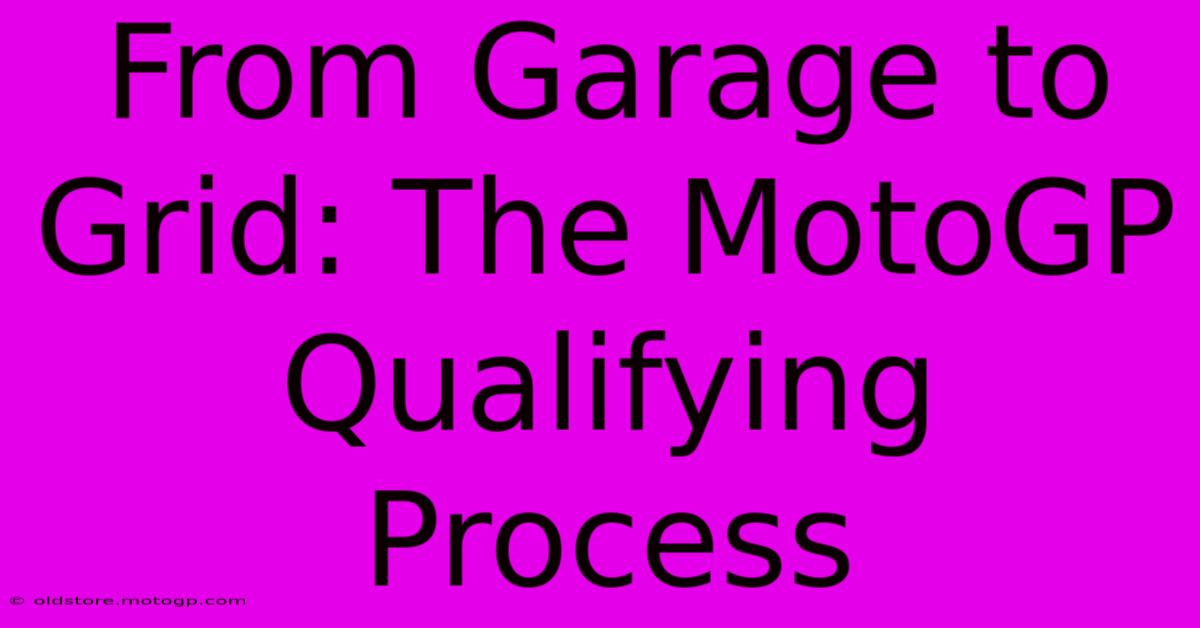From Garage To Grid: The MotoGP Qualifying Process

Table of Contents
From Garage to Grid: The MotoGP Qualifying Process
The roar of the engines, the smell of burning rubber, the sheer spectacle of MotoGP – it all culminates in the race, but the drama often begins long before the lights go out. Understanding the intricate qualifying process is key to appreciating the strategic battles and nail-biting moments that shape the grid. This comprehensive guide unravels the complexities of how MotoGP riders fight for pole position.
The Qualifying Format: A Breakdown
MotoGP qualifying is a multi-stage process designed to separate the wheat from the chaff, rewarding skill and consistency. The current format typically involves:
FP1 & FP2 (Free Practice):
These sessions are crucial for riders to get acquainted with the track, test different setup configurations, and gather essential data. While not directly impacting grid positions, they’re vital for setting the stage for the qualifying sessions. Teams analyze data meticulously, aiming for optimal bike performance for the qualifying runs. Think of these as the preparation phase, a crucial foundation for the battle ahead.
FP3 (Free Practice 3):
FP3 adds another layer of complexity. While not technically a qualifying session, the combined times from FP1, FP2, and FP3 determine who progresses directly to Q2. The top 10 riders from the combined times automatically advance. This session is a high-stakes mini-qualifying session in itself, setting the stage for the final shootouts. It's a critical test of pace and consistency.
Q1 (Qualifying 1):
The remaining riders (positions 11-24) compete in Q1, a 15-minute shootout. Only the two fastest riders from Q1 advance to Q2. This session is often characterized by intense battles and risky maneuvers, as riders push their limits to secure a coveted spot in the final qualifying session. The pressure is immense, as even a small mistake can cost a place in Q2.
Q2 (Qualifying 2):
The top ten riders from FP3, along with the two fastest riders from Q1, now participate in Q2. This is the ultimate showdown, a 15-minute session to decide pole position and the all-important front row grid slots. Every tenth of a second matters, with riders pushing their machines – and themselves – to the absolute limit. This is where the true battle for the best starting position unfolds.
Strategic Considerations: The Art of Qualifying
Qualifying in MotoGP is not just about raw speed; it's a delicate dance of strategy and precision. Teams and riders consider several crucial factors:
-
Tire Management: Selecting the right tire compound for each run is critical. Finding the balance between immediate pace and tire longevity is crucial, especially in the hotter conditions. A worn tire can dramatically impact lap times.
-
Track Conditions: Temperature, humidity, and even sunlight can dramatically alter track grip and optimal riding lines. Adaptability and track awareness are paramount.
-
Slipstream: Utilizing the slipstream of other riders to improve speed down the straights is a common tactic, requiring impeccable timing and anticipation.
-
Mechanical Issues: A single mechanical problem can ruin a rider's qualifying session. Teams must ensure their bikes are in perfect condition to withstand the high demands of these intense sessions.
Beyond the Timesheet: The Human Element
While timesheets tell part of the story, qualifying is also a testament to the immense pressure and mental fortitude of the riders. The sheer intensity, the weight of expectation, and the knowledge that a poor qualifying performance can significantly impact race results adds a human dimension to the seemingly mechanical process.
Conclusion: The MotoGP qualifying process is a fascinating blend of technical prowess, strategic thinking, and human resilience. From the meticulous preparation in free practice to the nail-biting finishes of Q1 and Q2, it's a captivating spectacle that sets the stage for the thrilling races that follow. Understanding the nuances of this process greatly enhances the enjoyment and appreciation of MotoGP as a whole.

Thank you for visiting our website wich cover about From Garage To Grid: The MotoGP Qualifying Process. We hope the information provided has been useful to you. Feel free to contact us if you have any questions or need further assistance. See you next time and dont miss to bookmark.
Featured Posts
-
The Impact Of The Moto Gp Points System On The Championship
Feb 20, 2025
-
Moto Gp Images The Grit And Glamour Explore Moto Gp Paddock Life
Feb 20, 2025
-
Cota F1 General Admission The Perfect Gift For F1 Fans
Feb 20, 2025
-
Experience The Innovation F1 Shuttle
Feb 20, 2025
-
Moto Gp Austin Dates Secure Your Spot At The Track
Feb 20, 2025
